|
|
|
Sort Order |
|
|
|
Items / Page
|
|
|
|
|
|
|
| Srl | Item |
| 1 |
ID:
085359
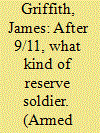

|
|
|
|
|
| Publication |
2009.
|
| Summary/Abstract |
Two concepts, Moskos's institutional-occupational orientations and Meyer and Allen's organizational commitment, were used to develop several hypotheses concerning relationships of soldiers' stated reasons for joining and staying in reserve military service to their stated career intentions and to perceived unit readiness. Survey data were obtained from first-term, junior-ranking enlisted Army National Guard soldiers nationwide at three time periods. Time periods corresponded to different phases of the Iraq conflict- before, during, and after the initial invasion. The number of soldiers at each time period equaled about 7,000 to 8,500. Results suggest material incentives may increase recruitment and retention, yet at the same time, such incentives may not enhance readiness. Rather, incentives fostering normative and affective commitments, such as joining and staying for camaraderie and service to country, were related both to self-reported career intentions and perceived unit readiness.
|
|
|
|
|
|
|
|
|
|
|
|
|
|
|
|
| 2 |
ID:
181153
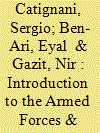

|
|
|
|
|
| Summary/Abstract |
This Armed Forces & Society forum is dedicated to exploring recent trends in the characteristics of military reserves and of the changing character of reserve forces within the armed forces within the military, the civilian sphere, and in between them. To bring new and critical perspectives to the study of reserve forces and civil–military relations, this introduction and the five articles that follow draw on two organizing conceptual models: The first portrays reservists as transmigrants and focuses on the plural membership of reservists in the military and in civilian society and the “travel” between them. The second model focuses on the multiple formal and informal compacts (contracts, agreements, or pacts) between reservists and the military.
|
|
|
|
|
|
|
|
|
|
|
|
|
|
|
|
| 3 |
ID:
181158
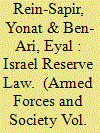

|
|
|
|
|
| Summary/Abstract |
Enacted in 2008, 60 years after Israel Defense Forces was established, the Israeli Reserves Law is a striking expression of the decline of military autonomy in a democratic country. While not aimed at reducing the military’s discretion in regard to the training, deployment, and compensation for reservists, the formal enactment of the Law in effect did so. The legislative process was preceded by a crisis between reservists and the military and was led by several reservists’ organizations who tried to improve the standing and resources allocated to the reserve forces. The article analyzes the impact of these organizations and the coalitions they created with politicians serving in the national parliament, the Knesset. By choosing the legislative option to improve the conditions of service for reservists, they de facto reduced military autonomy since the new Law mandated supervision and monitoring (by civilian institutions) of the service of reservists and extended into the core area of military action, the operational use of force. Thus, the actions of reservists’ organizations turned a bilateral tie between the military and its (reserve) soldiers into a trilateral one, comprising the military, reserve soldiers, and state institutions.
|
|
|
|
|
|
|
|
|
|
|
|
|
|
|
|
| 4 |
ID:
124061
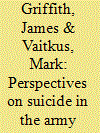

|
|
|
|
|
| Publication |
2013.
|
| Summary/Abstract |
Suicides in the US military were observed rising in 2004, most notably in the Army and Marine Corps, and particularly, in the Army National Guard (ARNG). Alarmed, Army leaders and researchers have offered various explanations and prescriptions, often lacking any evidence. In the present study, three data sets were used to examine evidence for various perspectives on suicide-dispositional risk, social cognitive, stressor-strain, and social cultural/institutional, each having different emphases on relevant explanatory variables and underlying mechanisms of suicide. Primary risk factors associated with having committed suicide among the 2007-2010 ARNG suicide cases were age (young), gender (male), and race (white), supporting the dispositional risk perspective on suicide. Some evidence supported the stressor-strain perspective in that postdeployment loss of a significant other and a major life change showed statistically significant, yet weaker associations with increased suicide intentions. Implications of results are discussed for future research and preventive strategies.
|
|
|
|
|
|
|
|
|
|
|
|
|
|
|
|
| 5 |
ID:
178186
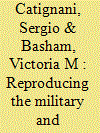

|
|
|
|
|
| Summary/Abstract |
The notions that military violence engenders security and that military service is a selfless and necessary act are orthodoxies in political, military and scholarly debate. The UK Army Reserve’s recent expansion prompts reconsideration of this orthodoxy, particularly in relation to the suggestion that reservists serve selflessly. Drawing on fieldwork with British Army reservists and their spouses/partners, we examine how this orthodoxy allows reservists to engage in everyday embodied performances, and occasionally articulations, of the need to serve, in order to free themselves up from household responsibilities. This supposed necessity of military service necessitates heteropatriarchal divisions of labour, which facilitate participation in military service and the state’s ability to conduct war/war preparations. However, while reserve service is represented as sacrificial and necessary, it is far more self-serving and is better understood as ‘serious leisure’, an activity whose perceived importance engenders deep self-fulfilment. By showing that the performances of sacrifice and necessity reservists rely on are selfish, not selfless, we show how militarism is facilitated by such everyday desires. We conclude by reflecting on how exposing reserve service as serious leisure could contribute to problematizing the state’s ability to rely on everyday performances and articulations of militarism and heteropatriarchy to prepare for and wage war.
|
|
|
|
|
|
|
|
|
|
|
|
|
|
|
|
| 6 |
ID:
107664
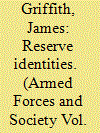

|
|
|
|
|
| Publication |
2011.
|
| Summary/Abstract |
Identities of reservists, primarily those of the U.S. military, are examined in the context of identity theory. In the current study, previously acknowledged identities of reservists are reliably measured and are shown to have construct validity. Scales were constructed from items on a previous survey of National Guard members (N = 1,256). Survey data were then used to establish scale reliability, both exploratory factor analysis and internal reliability. Scales had construct validity: Scale scores supported hypotheses derived from identity theory concerning relationships among identities, attitudes, and behavioral intentions. The importance of reserve identities to recruitment, retention, and readiness, including adaptability to deployment stressors is discussed. Identities also have implications for the broader issue of civilian-military relations.
|
|
|
|
|
|
|
|
|
|
|
|
|
|
|
|
| 7 |
ID:
104083
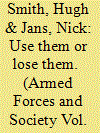

|
|
|
|
|
| Publication |
2011.
|
| Summary/Abstract |
This article reviews the history of military reserves in Australia with particular reference to the Army Reserve. It shows how the importance of reserves in Australia has waxed and waned across the past two centuries, from an early situation of primacy in the colonial period. The importance of reserves has reemerged in the post-Cold War era, with new forms of reserve organization evolving alongside ''conventional'' reserve forces. The authors discuss the extent to which these developments need to be accompanied by attention to cultural and personnel management issues and to enhanced reserves-regular integration. Despite the challenge of juggling civilian employment with reserve commitments, most reservists appear to welcome a greater, rather than a token, obligation to serve. There is a viable and meaningful role for the reserves provided that the Australian Defence Force and the government are prepared to devote sufficient effort to them and to assign them appropriate tasks.
|
|
|
|
|
|
|
|
|
|
|
|
|
|
|
|
|
|
|
|
|